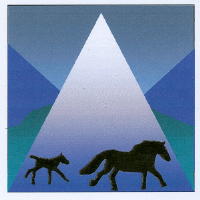These Two!
/It had been a long day. As I drove the lane on the way to check a newborn calf, I scanned the pony pasture looking for Calista and Mayflower. I was preparing for bringing them in for the night when I got back. When I spied them, they were about a half mile from my house, so I knew a walk was in front of me as light was quickly fading from the day. Imagine my elation, then, when I returned to my house and found that they had run to the waterer at the barn during my absence. This was the fourth evening in a row that these two had made my life so much easier.
The previous night, I had misjudged the weather forecast. Thunder and lightning had begun earlier than I expected, and when I went out to do my last pony chores of the day, occasional rain drops began to fall. The sky was an amazing red color, and with the flashes of lightning, it almost looked like it was on fire. Unfortunately the lightning drew nearer as my chores drug on, so when it was time to fetch Calista and Mayflower, I took a route that avoided ridgetops, hoping I wouldn’t have to walk into the open pasture in search of my girls. What a relief it was, then, when I saw them approaching the barn with their own bodies, like mine, bent against the rain that was beginning to fall in earnest. By the time I got them tucked into the foaling shed for the night, we were all soaked, but we were safe and able to appreciate the brilliant, if electric, show in the sky. The next morning the water in my rain gauge had a reddish tinge to it. I later learned we had had smoke in the atmosphere from a distant wildfire.
The night before that, I had gone out just before dark and didn’t see the girls anywhere. I began calling their names as I walked. After several minutes, I heard thundering hooves and here they came from the far end of the pasture at full speed. As they got closer, I saw that it was Mayflower, the foal, that was in the lead by forty yards. She almost came all the way to me but then veered to follow her mother to the barn. I had been wondering who was responsible for coming when I called, and I think I got my answer that night! Warmed my heart!
The first night in this helpful series, it had been another long, tiring day and I was late getting out to do chores. It was nearly dark when it was time to go find Calista and Mayflower. Imagine my appreciation then when, after fetching a halter, I looked up to see Calista and Mayflower not fifty feet from me heading my way. These two made my day again!
None of the four nights when Calista and Mayflower were so helpful were conducive to picture-taking. I was just intent on getting the girls where they were supposed to be before dark. So the photo here was taken one morning during the string of days when I was feeling so appreciative of these two.
© Jenifer Morrissey, 2021
You can find more stories like this one in my book What an Honor, available internationally by clicking here or on the book cover.




















































